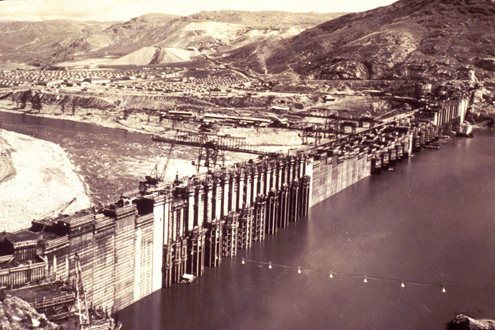Grand Coulee Dam was built as part of the Bureau of Reclamation’s Columbia Basin Project to provide water for agriculture in central Washington State.

When construction of the dam was completed in 1942, the waters behind the dam rose by 380 feet to an elevation of 1,290 feet above sea level.
The Columbia River from the Canadian border to the dam was no longer free flowing. Instead, this portion of the Columbia became a reservoir (called Franklin D. Roosevelt or Lake Roosevelt for short). At full pool, Lake Roosevelt has 630 miles of shoreline and extends north over 150 miles to the Canadian border.
As authorized by Congress in 1935, Lake Roosevelt and Grand Coulee Dam were designed to primarily support irrigation, flood control and power generation needs. Over time, Lake Roosevelt’s operations also sought to meet the recreation needs of up to 1.5 million people annually, and the water needs of downstream fisheries.
Lake operations refers to the ability of the Bureau of Reclamation, in concert with the U.S. Army Corps of Engineers (the Corps), the National Oceanic and Atmospheric Administration (NOAA) Fisheries, the Bonneville Power Administration (BPA) and other agencies, to raise and lower lake levels to meet irrigation, flood control, power generation, fishery, recreational and other needs.
From an operations perspective, the lake can fluctuate between minimum and maximum lake elevations. At its maximum, the lake’s elevation can rise to 1,290 feet above sea level and can hold over 9,000,000 acre-feet of water. That’s enough water to cover the states of Washington and Oregon with more than one inch of water. The minimum lake level for normal operations is 1,208 feet above sea level. So if you can imagine raising and lowering water within an eight story building that’s one half to one mile wide and over one hundred miles long, that’s the “box” within which Lake Roosevelt’s operations are managed.
Part of the importance of Lake Roosevelt is also its ability to refill. The run-off from rivers and tributaries into the lake allows it to refill about seven times in an average water year. By comparison, one of the other large reservoirs in the region, Hungry Horse, could not refill in the same year if it were emptied.
Meeting the many and varied operational demands put on Lake Roosevelt are very complex for two reasons. First, the multiple purposes Grand Coulee Dam and Lake Roosevelt support can cause conflict. For instance, flood control needs mandate that by late April or early May Lake Roosevelt be drawn down to a level that provides a high probability that downstream flood control needs will be met. This action, however, can affect the amount of water available to assist with flows for downstream fisheries. Likewise, spring draw downs of the reservoir must be done in a manner that assures for refill of Lake Roosevelt by summer. This refill affects not only meeting recreational needs, but the availability of water releases to assist downstream fisheries in August/September.
The second ongoing complexity is the hydrologic (or water) cycle. Weather patterns are unpredictable from year to year, month to month and sometimes week to week. As such, the best laid plans of managers in predicting things like the rate of runoff due to snow melt may need to be modified quickly and with little warning. Several teams of managers from both public and private agencies assist with various processes that help determine operational decisions.
Click here for Bureau of Reclamation Lake Roosevelt updates. Click here for U.S. Army Corps of Engineers Columbia River Basin Water Management team updates.
Future Lake Roosevelt operations may also change based on implementation of the Columbia River Treaty. Click here for updates.

